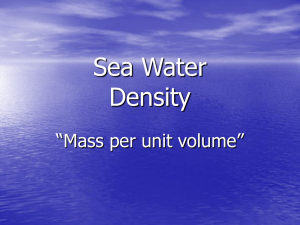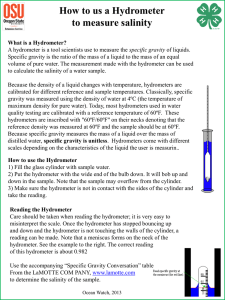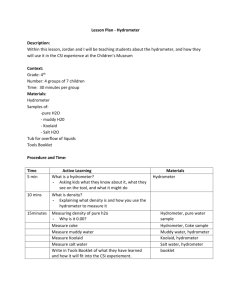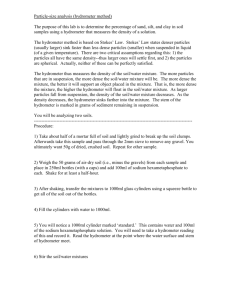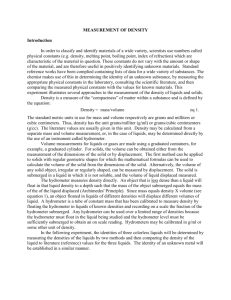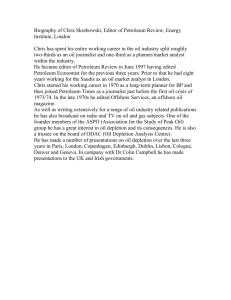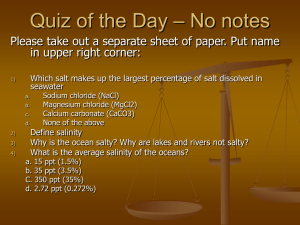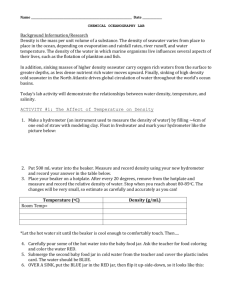Density, Relative Density (Specific Gravity), or API Gravity of Crude
advertisement
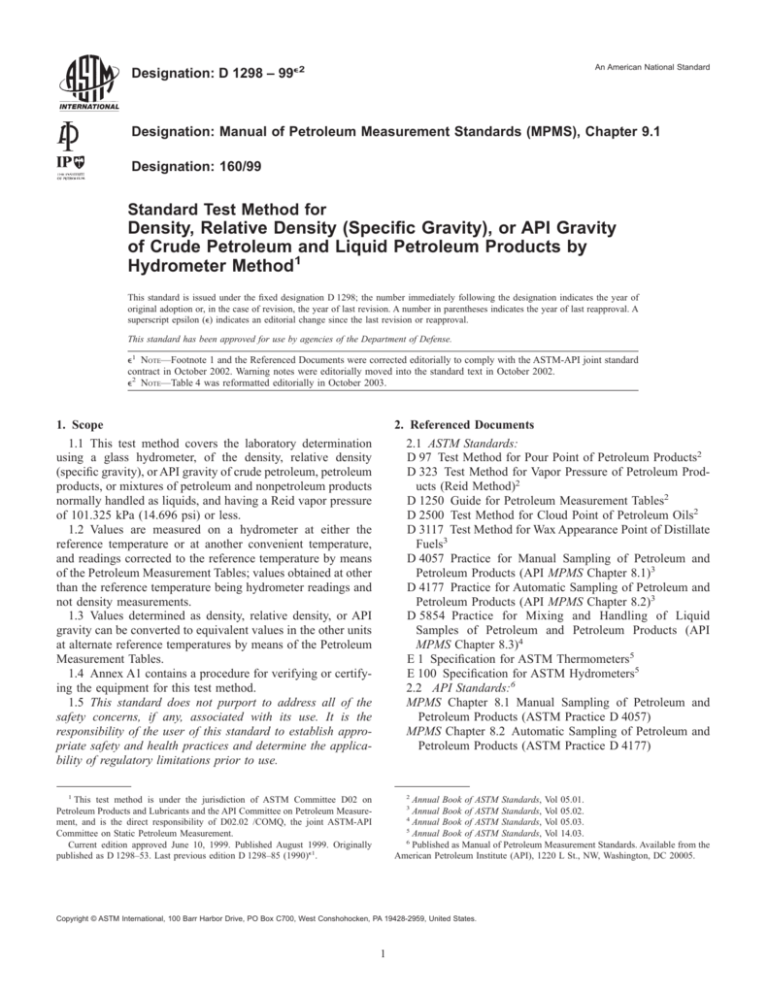
An American National Standard Designation: D 1298 – 99e2 Designation: Manual of Petroleum Measurement Standards (MPMS), Chapter 9.1 Designation: 160/99 Standard Test Method for Density, Relative Density (Specific Gravity), or API Gravity of Crude Petroleum and Liquid Petroleum Products by Hydrometer Method1 This standard is issued under the fixed designation D 1298; the number immediately following the designation indicates the year of original adoption or, in the case of revision, the year of last revision. A number in parentheses indicates the year of last reapproval. A superscript epsilon (e) indicates an editorial change since the last revision or reapproval. This standard has been approved for use by agencies of the Department of Defense. e1 NOTE—Footnote 1 and the Referenced Documents were corrected editorially to comply with the ASTM-API joint standard contract in October 2002. Warning notes were editorially moved into the standard text in October 2002. e2 NOTE—Table 4 was reformatted editorially in October 2003. 2. Referenced Documents 2.1 ASTM Standards: D 97 Test Method for Pour Point of Petroleum Products2 D 323 Test Method for Vapor Pressure of Petroleum Products (Reid Method)2 D 1250 Guide for Petroleum Measurement Tables2 D 2500 Test Method for Cloud Point of Petroleum Oils2 D 3117 Test Method for Wax Appearance Point of Distillate Fuels3 D 4057 Practice for Manual Sampling of Petroleum and Petroleum Products (API MPMS Chapter 8.1)3 D 4177 Practice for Automatic Sampling of Petroleum and Petroleum Products (API MPMS Chapter 8.2)3 D 5854 Practice for Mixing and Handling of Liquid Samples of Petroleum and Petroleum Products (API MPMS Chapter 8.3)4 E 1 Specification for ASTM Thermometers5 E 100 Specification for ASTM Hydrometers5 2.2 API Standards:6 MPMS Chapter 8.1 Manual Sampling of Petroleum and Petroleum Products (ASTM Practice D 4057) MPMS Chapter 8.2 Automatic Sampling of Petroleum and Petroleum Products (ASTM Practice D 4177) 1. Scope 1.1 This test method covers the laboratory determination using a glass hydrometer, of the density, relative density (specific gravity), or API gravity of crude petroleum, petroleum products, or mixtures of petroleum and nonpetroleum products normally handled as liquids, and having a Reid vapor pressure of 101.325 kPa (14.696 psi) or less. 1.2 Values are measured on a hydrometer at either the reference temperature or at another convenient temperature, and readings corrected to the reference temperature by means of the Petroleum Measurement Tables; values obtained at other than the reference temperature being hydrometer readings and not density measurements. 1.3 Values determined as density, relative density, or API gravity can be converted to equivalent values in the other units at alternate reference temperatures by means of the Petroleum Measurement Tables. 1.4 Annex A1 contains a procedure for verifying or certifying the equipment for this test method. 1.5 This standard does not purport to address all of the safety concerns, if any, associated with its use. It is the responsibility of the user of this standard to establish appropriate safety and health practices and determine the applicability of regulatory limitations prior to use. 1 This test method is under the jurisdiction of ASTM Committee D02 on Petroleum Products and Lubricants and the API Committee on Petroleum Measurement, and is the direct responsibility of D02.02 /COMQ, the joint ASTM-API Committee on Static Petroleum Measurement. Current edition approved June 10, 1999. Published August 1999. Originally published as D 1298–53. Last previous edition D 1298–85 (1990)e1. 2 Annual Book of ASTM Standards, Vol 05.01. Annual Book of ASTM Standards, Vol 05.02. Annual Book of ASTM Standards, Vol 05.03. 5 Annual Book of ASTM Standards, Vol 14.03. 6 Published as Manual of Petroleum Measurement Standards. Available from the American Petroleum Institute (API), 1220 L St., NW, Washington, DC 20005. 3 4 Copyright © ASTM International, 100 Barr Harbor Drive, PO Box C700, West Conshohocken, PA 19428-2959, United States. 1 D 1298 – 99e2 appropriate hydrometer, also at a similar temperature, is lowered into the test portion and allowed to settle. After temperature equilibrium has been reached, the hydrometer scale is read, and the temperature of the test portion is taken. The observed hydrometer reading is reduced to the reference temperature by means of the Petroleum Measurement Tables. If necessary, the hydrometer cylinder and its contents are placed in a constant temperature bath to avoid excessive temperature variation during the test. MPMS Chapter 8.3 Mixing and Handling of Liquid Samples of Petroleum and Petroleum Products (ASTM Practice D 5854) 2.3 Institute of Petroleum Standards:7 IP 389 Determination of wax appearance temperature (WAT) of middle distillate fuels by differential thermal analysis (DTA) or differential scanning calorimetry (DSC) IP Standard Methods Book, Appendix A, Specifications – IP Standard Thermometers 2.4 ISO Standards:8 ISO 649-1 Laboratory glassware – Density hydrometers for general purpose – Part 1: Specification 5. Significance and Use 5.1 Accurate determination of the density, relative density (specific gravity), or API gravity of petroleum and its products is necessary for the conversion of measured volumes to volumes or masses, or both, at the standard reference temperatures during custody transfer. 5.2 This test method is most suitable for determining the density, relative density (specific gravity), or API gravity of low viscosity transparent liquids. This test method can also be used for viscous liquids by allowing sufficient time for the hydrometer to reach equilibrium, and for opaque liquids by employing a suitable meniscus correction. 5.3 When used in connection with bulk oil measurements, volume correction errors are minimized by observing the hydrometer reading at a temperature close to that of the bulk oil temperature. 5.4 Density, relative density (specific gravity), or API gravity is a factor governing the quality and pricing of crude petroleum. However, this property of petroleum is an uncertain indication of its quality unless correlated with other properties. 5.5 Density is an important quality indicator for automotive, aviation and marine fuels, where it affects storage, handling and combustion. 3. Terminology 3.1 Definitions of Terms Specific to This Standard: 3.1.1 density, n—the mass of liquid per unit volume at 15°C and 101.325 kPa with the standard unit of measurement being kilograms per cubic metre. 3.1.1.1 Discussion—Other reference temperatures, such as 20°C may be used for some products or in some locations. Less preferred units of measurement; for example, kg/L or g/mL are still in use. 3.1.2 relative density (specific gravity), n—the ratio of the mass of a given volume of liquid at a specific temperature to the mass of an equal volume of pure water at the same or different temperature. Both reference temperatures shall be explicitly stated. 3.1.2.1 Discussion—Common reference temperatures include 60/60°F, 20/20°C, 20/4°C. The historic deprecated term specific gravity may still be found. 3.1.3 API gravity, n—a special function of relative density (specific gravity) 60/60°F, represented by: ° API 5 141.5/~sp gr 60/60°F! 2 131.5 (1) 3.1.3.1 Discussion—No statement of reference temperature is required, as 60°F is included in the definition. 3.1.4 observed values, n—values observed at temperatures other than the specified reference temperature. These values are only hydrometer readings and not density, relative density (specific gravity), or API gravity at that other temperature. 3.1.5 cloud point, n—temperature at which a cloud of wax crystals first appears in a liquid when it is cooled under specific conditions. 3.1.6 pour point, n—lowest temperature at which a test portion of crude petroleum or petroleum product will continue to flow when it is cooled under specified conditions. 3.1.7 wax appearance temperature (WAT), n—temperature at which waxy solids form when a crude petroleum or petroleum product is cooled under specified conditions. 6. Apparatus 6.1 Hydrometers, of glass, graduated in units of density, relative density, or API gravity as required, conforming to Specification E 100 or ISO 649-1, and the requirements given in Table 1. 6.1.1 The user should ascertain that the instruments used for this test conform to the requirements set out above with respect to materials, dimensions, and scale errors. In cases where the instrument is provided with a calibration certificate issued by a recognized standardizing body, the instrument is classed as certified and the appropriate corrections listed shall be applied TABLE 1 Recommended Hydrometers Units 4. Summary of Test Method 4.1 The sample is brought to a specified temperature and a test portion is transferred to a hydrometer cylinder that has been brought to approximately the same temperature. The ScaleA Range Total Density, kg/m3 at 15°C 600 - 1100 20 600 - 1100 50 600 - 1100 50 Relative density (specific 0.600 - 1.100 0.020 gravity) 60/60°F 0.600 - 1.100 0.050 0.600 - 1.100 0.050 Relative density (specific gravity), 60/60°F 0.650 - 1.100 0.050 API −1 - +101 12 7 Available from Institute of Petroleum, 61 New Cavendish St., London, W1M 8AR, UK. 8 Available from American National Standards Institute, 11 W 42nd St., 13th floor, New York, NY 10036. A Interval and Error relate to Scale. 2 Meniscus Each IntervalA ErrorA Correction Unit 0.2 6 0.2 +0.3 0.5 6 0.3 +0.7 1.0 6 0.6 +1.4 0.0002 6 0.0002 +0.0003 0.0005 6 0.0003 +0.0007 0.001 6 0.0006 +0.0014 0.0005 60.0005 0.1 6 0.1 D 1298 – 99e2 7.3.1 Volatile Crude Petroleum and Petroleum Products Having an RVP Greater than 50 kPa—Mix the sample in its original closed container in order to minimize the loss of light components. to the observed readings. Instruments that satisfy the requirements of this test method, but are not provided with a recognized calibration certificate, are classed as uncertified. 6.2 Thermometers, having range, graduation intervals and maximum permitted scale error shown in Table 2 and conforming to Specification E 1 or IP Appendix A. 6.2.1 Alternate measuring devices or systems may be used, provided that the total uncertainty of the calibrated system is no greater than when using liquid-in-glass thermometers. 6.3 Hydrometer Cylinder, clear glass, plastic (see 6.3.1), or metal. The inside diameter of the cylinder shall be at least 25 mm greater than the outside diameter of the hydrometer and the height shall be such that the appropriate hydrometer floats in the test portion with at least 25 mm clearance between the bottom of the hydrometer and the bottom of the cylinder. 6.3.1 Hydrometer cylinders constructed of plastic materials shall be resistant to discoloration or attack by oil samples and shall not affect the material being tested. They shall not become opaque under prolonged exposure to sunlight. 6.4 Constant-Temperature Bath, if required, of dimensions such that it can accommodate the hydrometer cylinder with the test portion fully immersed below the test portion liquid surface, and a temperature control system capable of maintaining the bath temperature within 0.25°C of the test temperature throughout the duration of the test. 6.5 Stirring Rod, optional, of glass or plastic, approximately 400 mm in length. NOTE 1—Mixing volatile samples in open containers will lead to loss of light components and consequently affect the value of the density obtained. 7.3.2 Waxy Crude Petroleum—If the petroleum has a pour point above 10°C, or a cloud point or WAT above 15°C, warm the sample to 9°C above the pour point, or 3°C above the cloud point or WAT, prior to mixing. Whenever possible, mix the sample in its original closed container in order to minimize the loss of light components. 7.3.3 Waxy Distillate—Warm the sample to 3°C above its cloud point or WAT prior to mixing. 7.3.4 Residual Fuel Oils—Heat the sample to the test temperature prior to mixing (see 8.1.1 and Note 4). 7.4 Additional information on the mixing and handling of liquid samples will be found in Practice D 5854 (API MPMS Chapter 8.3). 8. Procedure 8.1 Temperature of Test: 8.1.1 Bring the sample to the test temperature which shall be such that the sample is sufficiently fluid but not so high as to cause the loss of light components, nor so low as to result in the appearance of wax in the test portion. NOTE 2—The density, relative density or API gravity determined by the hydrometer is most accurate at or near the reference temperature. NOTE 3—The volume and density, the relative density, and the API corrections in the Petroleum Measurement Tables are based on the average expansions of a number of typical materials. Since the same coefficients were used in compiling each set of tables, corrections made over the same temperature interval minimize errors arising from possible differences between the coefficient of the material under test and the standard coefficients. This effect becomes more important as temperatures diverge from the reference temperature. NOTE 4—The hydrometer reading is obtained at a temperature appropriate to the physico-chemical characteristics of the material under test. This temperature is preferably close to the reference temperature, or when the value is used in conjunction with bulk oil measurements, within 3°C of the bulk temperature (see 5.3). 7. Sampling 7.1 Unless otherwise specified, samples of non-volatile petroleum and petroleum products shall be taken by the procedures described in Practices D 4057 (API MPMS Chapter 8.1) and D 4177 (API MPMS Chapter 8.2). 7.2 Samples of volatile crude petroleum or petroleum products are preferably taken by Practice D 4177 (API MPMS Chapter 8.2), using a variable volume (floating piston) sample receiver to minimize any loss of light components which may affect the accuracy of the density measurement. In the absence of this facility, extreme care shall be taken to minimize these losses, including the transfer of the sample to a chilled container immediately after sampling. 7.3 Sample Mixing—may be necessary to obtain a test portion representative of the bulk sample to be tested, but precautions shall be taken to maintain the integrity of the sample during this operation. Mixing of volatile crude petroleum or petroleum products containing water or sediments, or both, or the heating of waxy volatile crude petroleum or petroleum products may result in the loss of light components. The following sections (7.3.1 to 7.3.4) will give some guidance on sample integrity maintenance. 8.1.2 For crude petroleum, bring the sample close to the reference temperature or, if wax is present, to 9°C above its pour point or 3°C above its cloud point or WAT, whichever is higher. NOTE 5—For crude petroleum an indication of the WAT can be found using IP 389, with the modification of using 50 µL 6 5 µL of sample. The precision of WAT for crude petroleum using this technique has not been determined. 9. Apparatus Verification or Certification 9.1 Hydrometers and thermometers shall be verified in accordance with the procedures in Annex A1. TABLE 2 Recommended Thermometers Scale Range Graduation Interval Scale Error °C °C °F −1 - +38 −20 - +102 −5 - +215 0.1 0.2 0.5 6 0.1 6 0.15 6 0.25 10. Procedure 10.1 Bring the hydrometer cylinder and thermometer to within approximately 5°C of the test temperature. 10.2 Transfer the sample to the clean, temperaturestabilized hydrometer cylinder without splashing, to avoid the 3 D 1298 – 99e2 10.12.1 For transparent liquids, record the hydrometer reading as the point on the hydrometer scale at which the principal surface of the liquid cuts the scale by placing the eye slightly below the level of the liquid and slowly raising it until the surface, first seen as a distorted ellipse, appears to become a straight line cutting the hydrometer scale (see Fig. 1). 10.12.2 For opaque liquids record the hydrometer reading at the point on the hydrometer scale to which the sample rises, by observing with the eye slightly above the plane of the surface of the liquid (see Fig. 2). formation of air bubbles, and minimize evaporation of the lower boiling constituents of more volatile samples. (Warning—Extremely flammable. Vapors may cause flash fire!) 10.3 Transfer highly volatile samples by siphoning or water displacement. (Warning—Siphoning by mouth could result in ingestion of sample!) 10.3.1 Samples containing alcohol or other water-soluble materials should be placed into the cylinder by siphoning. 10.4 Remove any air bubbles formed after they have collected on the surface of the test portion, by touching them with a piece of clean filter paper before inserting the hydrometer. 10.5 Place the cylinder containing the test portion in a vertical position in a location free from air currents and where the temperature of the surrounding medium does not change more than 2°C during the time taken to complete the test. When the temperature of the test portion differs by more than 2°C from ambient, use a constant temperature bath to maintain an even temperature throughout the test duration. 10.6 Insert the appropriate thermometer or temperature measurement device and stir the test portion with a stirring rod, using a combination of vertical and rotational motions to ensure uniform temperature and density throughout the hydrometer cylinder. Record the temperature of the sample to the nearest 0.1°C and remove the thermometer/temperature measuring device and stirring rod from the hydrometer cylinder. NOTE 7—When testing opaque liquids using a metal hydrometer cylinder, accurate readings of the hydrometer scale can only be ensured if the liquid surface is within 5 mm of the top of the cylinder. 10.13 Immediately after recording the hydrometer scale reading, carefully lift the hydrometer out of the liquid, insert the thermometer or temperature measurement device and stir the test portion vertically with the stirring rod. Record the temperature of the test portion to the nearest 0.1°C. If this temperature differs from the previous reading (10.6) by more than 0.5°C, repeat the hydrometer observations and thermometer observations until the temperature becomes stable within 0.5°C. If a stable temperature cannot be obtained, place the hydrometer cylinder in a constant temperature bath and repeat the procedure from 10.5. NOTE 6—If a liquid-in-glass thermometer is used, this is commonly used as the stirring rod. 10.7 Lower the appropriate hydrometer into the liquid and release when in a position of equilibrium, taking care to avoid wetting the stem above the level at which it floats freely. For low viscosity transparent or translucent liquids observe the meniscus shape when the hydrometer is pressed below the point of equilibrium about 1 to 2 mm and allowed to return to equilibrium. If the meniscus changes, clean the hydrometer stem and repeat until the meniscus shape remains constant. 10.8 For opaque viscous liquids, allow the hydrometer to settle slowly into the liquid. 10.9 For low viscosity transparent or translucent liquids depress the hydrometer about two scale divisions into the liquid, and then release it, imparting a slight spin to the hydrometer on release to assist in bringing it to rest floating freely from the walls of the hydrometer cylinder. Ensure that the remainder of the hydrometer stem, which is above the liquid level, is not wetted as liquid on the stem affects the reading obtained. 10.10 Allow sufficient time for the hydrometer to come to rest, and for all air bubbles to come to the surface. Remove any air bubbles before taking a reading (see 10.4). 10.11 If the hydrometer cylinder is made of plastic, dissipate any static charges by wiping the outside with a damp cloth. (Warning—Static charges often build up on plastic cylinders and may prevent the hydrometer from floating freely.) 10.12 When the hydrometer has come to rest floating freely away from the walls of the cylinder, read the hydrometer scale reading to the nearest one-fifth of a full scale division in accordance with 10.12.1 or 10.12.2. FIG. 1 Hydrometer Scale Reading for Transparent Liquids 4 D 1298 – 99e2 rr 5 1 – @23 3 10 –6 rt ~t – r! – 2 3 10–8 ~t – r!2# (2) where: rr = hydrometer reading at the reference temperature, r °C, and rt = hydrometer reading on the hydrometer scale whose reference temperature is t °C. 11.5 Convert the corrected hydrometer scale reading to density, relative density or API gravity using the appropriate parts of the Petroleum Measurement Tables referenced in Guide D 1250 according to the nature of the materials under test. Table 3 gives some examples of relevant table numbers in the Petroleum Measurement Tables. 11.5.1 The strictly correct procedure for the conversion is to use the computer implementation procedures contained in the Petroleum Measurement Tables and not the printed tables. If the printed tables are used, ensure that all errata discovered since original publication have been included in the version used. The tables include corrections for soda-lime glass expansion and contraction of the hydrometer over the temperature range, and thus the observed hydrometer reading is added directly after correction (11.2-11.4) as necessary. 11.5.2 To convert densities expressed in kg/m3 to densities expressed in g/mL or kg/L, divide by 103. 11.5.3 To convert hydrometer readings from one unit to another, Tables 51 (density at 15°C), 21 (relative density at 60/60°F) or 3 (API gravity), referenced in Guide D 1250, are appropriate. 12. Report 12.1 Report the final value as density, in kilograms per cubic metre, at the reference temperature, to the nearest 0.1 kg/m3. 12.2 Report the final value as density, in kilograms per litre or grams per millilitre at the reference temperature, to the nearest 0.0001. 12.3 Report the final value as relative density, with no dimensions, at the two reference temperatures, to the nearest 0.0001. 12.4 Report the final value as API gravity to the nearest 0.1° API. FIG. 2 Hydrometer Scale Reading for Opaque Fluids 10.14 If the test temperature is higher than 38°C, allow all hydrometers of the lead shot-in-wax type to drain and cool in a vertical position. 11. Calculation 11.1 Apply any relevant thermometer corrections to the temperature reading observed in 10.6 and 10.13 and record the average of those two temperatures to the nearest 0.1°C. 11.2 For opaque samples, apply the relevant meniscus correction given in Table 1 to the observed hydrometer reading (10.12.2) as hydrometers are calibrated to be read at the principal surface of the liquid. 13. Precision and Bias 13.1 Precision—The precision of the method as determined by statistical examination of interlaboratory results is as follows: 13.1.1 Repeatability—The difference between two test results, obtained by the same operator with the same apparatus under constant operating conditions on identical test material, would in the long run, in the normal and correct operation of the test method, exceed the values in Table 4 only in one case in twenty. NOTE 8—The meniscus correction for a particular hydrometer in use is determined by observing the maximum height above the principal surface of the liquid to which liquid rises on the hydrometer scale when the hydrometer in question is immersed in a transparent liquid having a surface tension similar to that of the sample under test. For hydrometers specified in this test method, the corrections in Table 1 are approximate. 11.3 Apply any hydrometer correction to the observed reading and record the corrected hydrometer scale reading to the nearest 0.1 kg/m3 in density, 0.0001 g/mL, kg/L or relative density, or 0.1° API. 11.4 If the hydrometer has been calibrated at a temperature other than the reference temperature, use the equation below to correct the hydrometer scale reading: TABLE 3 Example PMT Table Numbers Material Crude petroleum Petroleum products Lubricating oils 5 Density at 15°C Density at 20°C Relative Density °API kg/m3 kg/m3 at 60/60°F 53A 53B 53D 59A 59B 59D 23A 23B – 5A 5B 5D D 1298 – 99e2 TABLE 4 Precision Values 13.1.2 Reproducibility—The difference between two single and independent results obtained by different operators working in different laboratories on identical test material would, in the long run, in the normal and correct operation of the test method, exceed the following values only in one case in twenty. 13.2 Bias—Bias for this test method has not been determined. However, there should be no bias from absolute measurements, if the calibration of the hydrometer and the thermometer is traceable to International Standards, such as supplied by the National Institute of Standards and Technology. Product: Transparent Low-viscosity Liquids Temperature Range, °C (°F) Parameter Density Relative Density API Gravity –2 to 24.5 (29 to 76) –2 to 24.5 (29 to 76) (42 to 78) Units Repeatability Reproducibility kg/m3 kg/L or g/mL NONE 0.5 0.0005 0.0005 1.2 0.0012 0.0012 °API 0.1 0.3 Units Repeatability Reproducibility kg/m3 kg/L or g/mL NONE 0.6 0.0006 0.0006 1.5 0.0015 0.0015 °API 0.2 0.5 Product: Opaque Liquids Temperature Range, °C (°F) Parameter Density Relative Density API Gravity –2 to 24.5 (29 to 76) –2 to 24.5 (29 to 76) (42 to 78) 14. Keywords 14.1 API gravity; crude petroleum; density; hydrometer; Petroleum Measurement Tables; petroleum products; relative density; specific gravity ANNEX (Mandatory Information) A1. APPARATUS A1.1 Apparatus Verification and Certification A1.1.1 Hydrometers, shall either be certified or verified. Verification shall be either by comparison with a certified hydrometer (see 6.1.1) or by the use of a certified reference material (CRM) specific to the reference temperature used. A1.1.1.1 The hydrometer scale shall be correctly located within the hydrometer stem by reference to the datum mark. If the scale has moved, reject the hydrometer. A1.1.2 Thermometers, shall be verified at intervals of no more than six months for conformance with specifications. Either comparison with a referenced temperature measurement system traceable to an international standard, or a determination of ice point, is suitable. ASTM International takes no position respecting the validity of any patent rights asserted in connection with any item mentioned in this standard. Users of this standard are expressly advised that determination of the validity of any such patent rights, and the risk of infringement of such rights, are entirely their own responsibility. This standard is subject to revision at any time by the responsible technical committee and must be reviewed every five years and if not revised, either reapproved or withdrawn. Your comments are invited either for revision of this standard or for additional standards and should be addressed to ASTM International Headquarters. Your comments will receive careful consideration at a meeting of the responsible technical committee, which you may attend. If you feel that your comments have not received a fair hearing you should make your views known to the ASTM Committee on Standards, at the address shown below. This standard is copyrighted by ASTM International, 100 Barr Harbor Drive, PO Box C700, West Conshohocken, PA 19428-2959, United States. Individual reprints (single or multiple copies) of this standard may be obtained by contacting ASTM at the above address or at 610-832-9585 (phone), 610-832-9555 (fax), or service@astm.org (e-mail); or through the ASTM website (www.astm.org). 6
